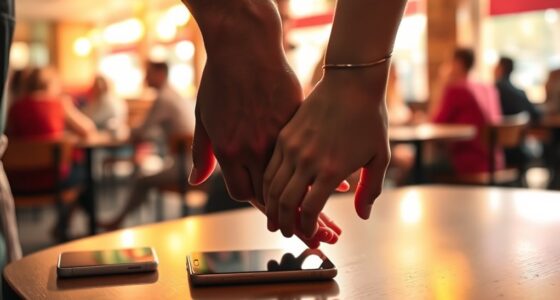When someone says “Hiya” during conflict, it’s more than just a casual greeting. It often hints at underlying emotional states, like friendliness, discomfort, or frustration, depending on tone and body language. Cultural context influences how you interpret it—what feels casual in one setting might seem dismissive in another. Pay close attention to non-verbal cues and tone to truly understand the message behind “Hiya.” If you want to uncover its deeper meanings, there’s more to contemplate.
Key Takeaways
- “Hiya” can signal friendliness or hidden tension, depending on tone and body language during conflict.
- Cultural context influences whether “Hiya” is perceived as respectful, casual, or dismissive.
- A cheerful tone suggests openness, while flat delivery may indicate discomfort or disagreement.
- Recognizing emotional cues alongside “Hiya” helps assess if the conflict is escalating or diffusing.
- Understanding underlying feelings behind “Hiya” aids in empathetic communication and conflict resolution.

Have you ever wondered what a simple greeting like “Hiya” can reveal in a conflict situation? It might seem like just a friendly, casual way to say hello, but in reality, it can carry much more beneath the surface. When used in tense moments, “Hiya” can serve as a subtle indicator of emotional nuances and cultural expressions that influence how conflicts unfold. You might notice that in some cultures, “Hiya” is a warm, genuine gesture, signaling openness and a desire to connect. In others, it might be more detached or even dismissive, revealing underlying tension or discomfort. Recognizing these differences allows you to interpret the emotional undertones behind the words and better understand the true state of the relationship.
Cultural expressions play a significant role in how greetings like “Hiya” are perceived. For example, in British slang, “Hiya” often feels informal and friendly, used among acquaintances or friends. Meanwhile, in Australian English, it can be a quick, familiar way to acknowledge someone without necessarily indicating warmth. In contrast, in some Asian cultures, greetings are more formal, and a casual “Hiya” might seem out of place or even disrespectful if the context calls for more respectful language. These cultural nuances shape the emotional landscape of interactions, especially during conflicts, where misunderstandings can escalate if the greeting is misinterpreted.
In conflict resolution, decoding these emotional nuances is vital. When someone greets you with “Hiya,” pay attention to their tone, facial expressions, and body language. A cheerful tone may suggest they are trying to diffuse tension or keep things light, even if the conversation is serious. Conversely, a flat or strained delivery might reveal discomfort or frustration that you need to address more directly. Recognizing these cues helps you gauge whether the conflict is simmering beneath the surface or if the person is genuinely trying to maintain a friendly facade. It allows you to approach the situation with empathy, avoiding assumptions based solely on words, and instead focusing on the emotional context that words reveal.
Frequently Asked Questions
How Does “Hiya” Differ Across Various Cultures?
You might notice that “hiya” varies across cultures because of cultural nuances and language variations. In some places, it’s a casual greeting expressing friendliness, while in others, it might seem overly informal or even confusing. Knowing these differences helps you communicate better, respecting local customs. Pay attention to context and tone, as “hiya” can carry different connotations depending on cultural expectations and social norms.
Can “Hiya” Be Used to Escalate Conflicts Intentionally?
You might wonder if “hiya” can intentionally escalate conflicts. While it’s often a friendly greeting, tone interpretation plays a key role. If spoken with sarcasm or aggressive body language, it can carry emotional implications that escalate tensions. You should be mindful of context, tone, and non-verbal cues, as these elements influence how “hiya” is received, potentially turning a simple greeting into a trigger for conflict.
Is “Hiya” Effective in Resolving Serious Disputes?
Imagine a gentle ripple across still water—that’s the effect of “hiya” in serious disputes. Its tone and formality vary with cultural context, sometimes softening tension, other times confusing intent. You might find it effective if used warmly, but it can also be misinterpreted as dismissive. To resolve conflicts, consider the situation’s gravity and cultural nuances; a simple “hiya” can either bridge gaps or deepen divides.
How Should One Respond if “Hiya” Is Used Aggressively?
When someone uses “hiya” aggressively, you should first consider tone interpretation and body language cues. Respond calmly and avoid escalating the situation. You might say, “I sense tension; let’s talk calmly,” to defuse hostility. Pay attention to their body language—crossed arms or clenched fists can signal defensiveness. Your goal is to maintain composure, clarify intentions, and steer the conversation toward resolution rather than confrontation.
What Are Alternative Phrases to “Hiya” in Conflict Settings?
Ever wondered what to say instead of “hiya” in tense moments? You can opt for friendly greetings like “hello,” “good morning,” or “how are you?” to set a calm tone. Casual expressions like “hey there” or “what’s up?” can also work, but be mindful of the situation. These alternatives help maintain a respectful atmosphere and encourage positive dialogue during conflicts, making resolution smoother.
Conclusion
So, next time you hear “hiya,” remember it’s more than just a casual greeting. It’s a gentle nudge to open the door for understanding and connection. Instead of letting conflicts fester, use that friendly word to softly shift the energy toward harmony. Embrace “hiya” as a subtle invitation to listen, share, and find common ground. With a warm smile, you can turn small exchanges into stepping stones for peaceful resolutions.









